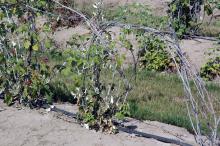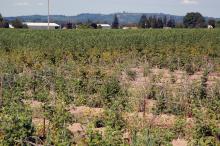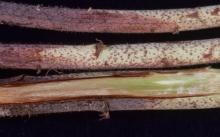Cause Verticillium dahliae, a fungus that has been reported in the PNW. The disease is particularly serious in black raspberry. It also attacks red raspberry but rarely. It is more often in 'Loganberry' and 'Youngberry' than in the 'Marion' and 'Evergreen' trailing berries. The fungus may live saprophytically in soil many years but can attack susceptible plant roots whenever they are placed in infested ground. The fungus grows into the xylem where it colonizes the plant through mycelial growth and conidial production. Fluid movement in the xylem passively transports the conidia. Once in the xylem, this fungus partially blocks water movement and produces toxins that result in wilt symptoms. Once the plant tissue dies, the fungus produces microsclerotia within the recently killed plant tissue, which are released into the soil as the tissues decompose. Interactions with the root-lesion nematode can increase disease incidence and severity. Infected plants may also be more prone to winter damage.
Symptoms New canes often wilt in mid-late summer with the onset of warmer weather. Bluish stripes or ribbons of infected tissue may extend up the canes from the ground. Wilted foliage ultimately takes on a scorched appearance from the bottom up, leaving a tuft of green leaves at the tip. Blades of wilted foliage drop prematurely, but the petiole often remains attached to the cane. Plants decline and eventually die. Initially, just one or a few canes on a plant may be affected, indicating that only a portion of the root system or crown has been damaged. Eventually, an entire clump may succumb. Disease plants may often be distributed in the field in discrete patches called "disease pockets."
Sampling A preplant soil test for propagules of this fungus will aid in site selection. The presence of any microsclerotia in the soil should be interpreted as a potential disease risk.
Cultural control This disease is virtually impossible to eradicate once it has been introduced into a field. Therefore, preventing its movement and establishment into clean fields is an important strategy for avoiding Verticillium wilt.
- Remove infected plants, and the plants on either side, to eliminate wilt spread. Do not replant where infections occurred.
- Do not track soil from infested areas into clean areas. Clean boots, equipment, and tools before leaving an infested area.
- Avoid planting after other susceptible crops, which may increase rather than lower the soil's Verticillium content. Susceptible crops include potato, tomato, strawberry, caneberry, stone fruit, eggplant, pepper, and, among nursery trees, maple, as well as many common weeds in the nightshade family.
- Plant only certified berry stock.
- Where possible, select well-drained land for black raspberry that has never grown that or other susceptible crops.
Chemical control Preplant soil fumigation is economical if Verticillium and root-lesion nematodes are in soil.
- Telone C-17 at 30 to 50 fl oz/1,000 ft of row using a single chisel per row on mineral soils. Allow 2 to 3 weeks between treating and planting or until odor leaves soil. Do not treat extremely heavy soils. 5-day reentry. Restricted-use pesticide.
- Vapam HL at 37.5 to 75 gal/A. Immediately roll the soil and follow up with tarps or a light watering. May use through an irrigation system. 5-day reentry. Restricted-use pesticide.
Reference Martin, R.R., Ellis, M.A., Williamson, B., and Williams, R.N. 2017. Compendium of Raspberry and Blackberry Diseases and Pests. 2nd edition. St. Paul, MN: APS Press.






